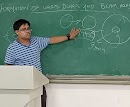Standard Model
A Brief overview on Fermion:- A complete go-through Analysis!!!
As in my previous
article on the Standard Model, I explained about the elementary particles in brief
and also briefly introduced the Standard Model of particle physics. If you
haven’t read that article then I strongly recommend you read that first to
understand this article in a more efficient way!!!
So, we all know
that standard model has 17 member particles….right???
But, these 17
particles are separated into two groups: Fermions and Bosons….and in this article
I am going to give a brief but concrete idea about Fermions….
Fermions have two
more subdivisions: Quarks and Leptons. A fermion is a particle which has half
odd integer spin (like. ½, 3/2) and always follows Fermi-Dirac Statistics. Along with these, a particle containing an odd number of fermions is also a fermion, like the nucleus of carbon-13. According to the spin-statistics theorem, fermions also always respect the Pauli
Exclusion Principle. Unlike Bosons, each Fermion particle has its own respective anti-particle.
I will write a detailed article on the Pauli Exclusion Principle
and Fermi-Dirac Statistics later.
The name ‘Fermion’
was named after Italian physicist Enrico Fermi. The name was coined by English theoretical
physicist Paul Dirac.
Fermion consists
of all quarks and leptons as well as all composite particles like baryons. Not
only that, but Fermions also include other composite particles like helium-3. A
fermion can be an elementary particle like electrons or up quark, or it also
can be a composite particle like proton or neutron. Only one thing we have to
keep in our mind that particles which have half-integer spin are fermions and
particles with integer spin are bosons. Also, fermions have conserved baryon or
lepton quantum number.
Since fermions
obey the Pauli Exclusion Principle, only one fermion can occupy a particular
quantum state at any given time.
All of the six quarks and six leptons are
divided into generations.
First Generation of
quarks:- Up and down
Second Generation
of quarks:- Charm and Strange
Third Generation
of quarks:- Top and Bottom
First Generation
of Leptons:- Electron and Electron Neutrino
Second Generation
of Leptons:- Muon and Muon Neutrino
Third Generation
of Leptons:- Tau and Tau Neutrino
The first
generation charged particles do not decay and that’s why all ordinary matter is
made of such particles. Whereas, particles in the second and third generation,
decay very quickly and thus, having a very short-lived and can only be observed
in very high energetic situation and environment. Every member of a Generation
has greater mass than members of the lower generation.
Neutrinos of all
generations do not decay and rarely interact with normal (baryonic) matter and
thus making them very difficult to detect. The reason for this nature is due to
the fact that they don’t carry an electric charge and their motion is directly
influenced only by the weak nuclear force or weak force.
And that’s it….that’s
all you need to know about the basics of fermions and now you can start your voyage…..
In my upcoming
articles, I will write about the basics of Gauge Bosons and Scalar boson. Along
with that, dedicated posts about quarks and leptons are also coming. After that,
I will explain each quark, lepton and boson. And not only these, separate articles on Pauli-Exclusion Principle and Fermi-Dirac Statistics are also coming.
So, be ready for these adventures too…..
So, don't forget to check these out. Once they are uploaded, the links will be available here......
To know basics of the quantum world, astronomy and space exploration you can check out my book "Through the wormhole" on amazon kindle.
You can directly talk with me on Instagram
To meet more physics Enthusiasts please join our Facebook Page
Also for the latest updates of my posts join me on TwitterTo meet more physics Enthusiasts please join our Facebook Page
Thanks for reading.....
See you next time!!!
-Ratnadeep Das Choudhury
Founder and Writer of The Dynamic Frequency














0 Comments